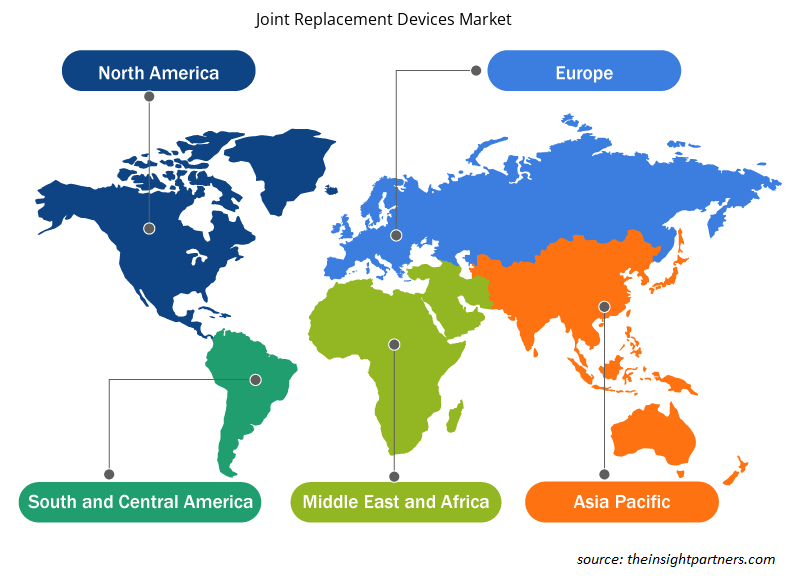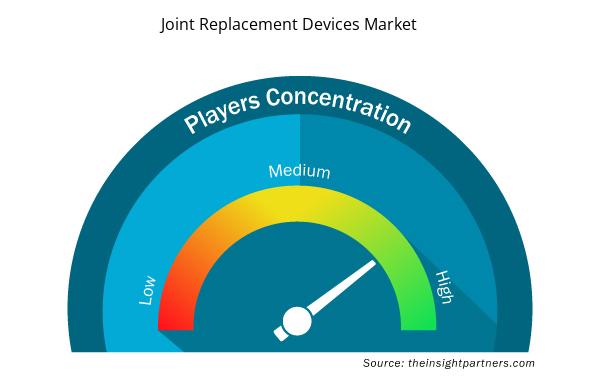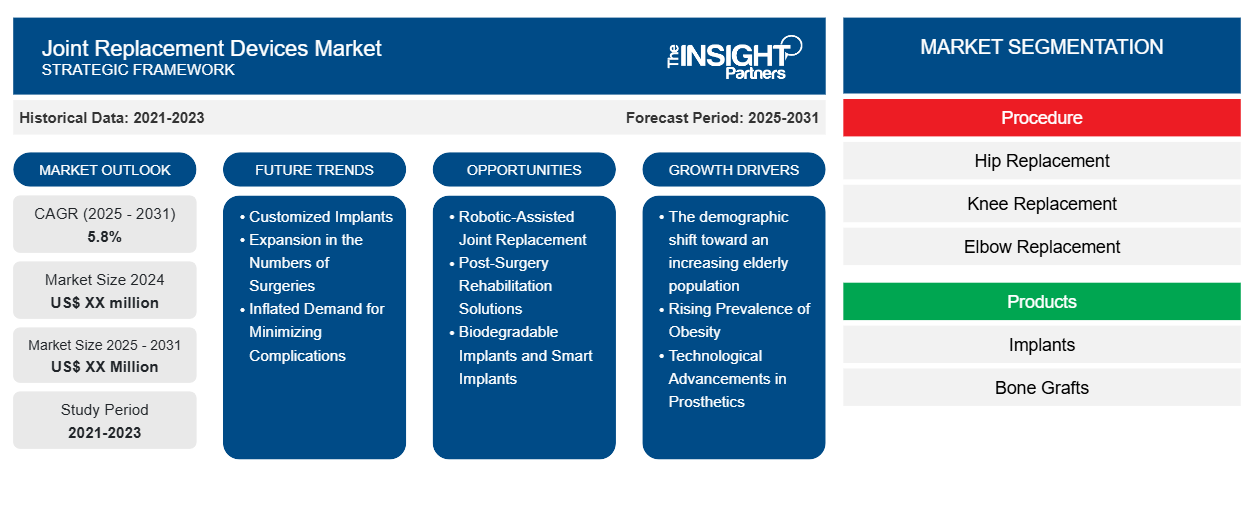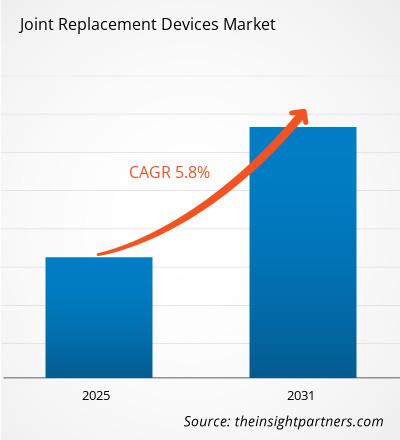Si prevede che il mercato dei dispositivi di sostituzione articolare registrerà un CAGR del 5,8% dal 2023 al 2031, con una dimensione di mercato in espansione da XX milioni di dollari nel 2023 a XX milioni di dollari entro il 2031.
Il report è segmentato per Procedura (Sostituzione dell'anca, Sostituzione del ginocchio, Sostituzione del gomito, Altri). Il report è segmentato per Prodotti (Impianti, Innesti ossei, Altri). Il report è segmentato per Tecnica (Chirurgia tradizionale, Chirurgia mininvasiva (MIS), Chirurgia assistita dal computer (CAS)). Il report è segmentato per Utente finale (Ospedali, Cliniche ortopediche, Centri chirurgici ambulatoriali). L'analisi globale è ulteriormente suddivisa a livello regionale e nei principali Paesi. Il report offre il valore in USD per l'analisi e i segmenti di cui sopra.
Scopo del rapporto
Il report Joint Replacement Devices Market di The Insight Partners mira a descrivere il panorama attuale e la crescita futura, i principali fattori trainanti, le sfide e le opportunità. Ciò fornirà spunti a vari stakeholder aziendali, come:
- Fornitori/produttori di tecnologia: per comprendere le dinamiche di mercato in evoluzione e conoscere le potenziali opportunità di crescita, consentendo loro di prendere decisioni strategiche informate.
- Investitori: condurre un'analisi completa delle tendenze relative al tasso di crescita del mercato, alle proiezioni finanziarie del mercato e alle opportunità esistenti lungo la catena del valore.
- Enti di regolamentazione: regolamentano le politiche e le attività di controllo sul mercato allo scopo di ridurre al minimo gli abusi, preservare la fiducia degli investitori e sostenere l'integrità e la stabilità del mercato.
Segmentazione del mercato dei dispositivi di sostituzione articolare
Procedura
- Sostituzione dell'anca
- Sostituzione del ginocchio
- Sostituzione del gomito
Prodotti
- Impianti
- Innesti ossei
Tecnica
- Chirurgia tradizionale
- Chirurgia mininvasiva
- Chirurgia assistita dal computer
Utente finale
- Ospedali
- Cliniche ortopediche
- Centri chirurgici ambulatoriali
Utente finale
- Ospedali
- Cliniche ortopediche
- Centri chirurgici ambulatoriali
Personalizza questo report in base alle tue esigenze
Riceverai la personalizzazione gratuita di qualsiasi report, comprese parti di questo report, o analisi a livello nazionale, pacchetto dati Excel, oltre a usufruire di grandi offerte e sconti per start-up e università
- Scopri le principali tendenze di mercato in questo rapporto.Questo campione GRATUITO includerà analisi di dati che spaziano dalle tendenze di mercato alle stime e alle previsioni.
Fattori trainanti della crescita del mercato dei dispositivi di sostituzione articolare
- Lo spostamento demografico verso una popolazione anziana in aumento: questo perché l'invecchiamento della popolazione mondiale è uno dei principali fattori che accelerano la crescita del mercato delle protesi articolari. Con l'aumento della longevità, le condizioni di salute tra cui l'osteoartrite, l'artrite reumatoide e l'usura delle articolazioni diventano più diffuse. In tali casi, tendono a sostituire chirurgicamente l'articolazione come mezzo per la gestione del dolore e per ripristinare la mobilità. Secondo le proiezioni dell'Organizzazione Mondiale della Sanità, si prevede che la popolazione di età pari o superiore a sessant'anni sarà almeno il doppio della popolazione attuale entro il 2050, con un conseguente aumento degli interventi chirurgici antropometrici che comportano la ricostruzione delle articolazioni in particolare.
- Aumento della prevalenza dell'obesità: l'obesità è un altro fattore importante che può aumentare il numero di operazioni alle articolazioni, in particolare quelle eseguite sulle articolazioni portanti come ginocchia e fianchi. Un peso corporeo eccessivo comporta un maggiore stress sulle articolazioni, aumentando il rischio di condizioni come l'osteoartrite. Le articolazioni sono le parti del corpo più comunemente sostituite, poiché è proprio per queste articolazioni che la prevalenza degli interventi chirurgici aumenta a causa dell'epidemiologia dell'obesità. Si stima che il tasso di obesità della popolazione americana odierna sia del 40% e tali pazienti devono sottoporsi a interventi chirurgici e riparazioni alle articolazioni a causa di complicazioni di salute derivanti dalle articolazioni.
- Progressi tecnologici in protesi: sempre più cambiamenti vengono apportati alle procedure chirurgiche delle articolazioni artificiali a causa dei progressi ottenuti nel campo della medicina. La ricerca e lo sviluppo di materiali avanzati in grado di sopportare carichi maggiori all'interno del corpo, nonché la robotica di precisione per la chirurgia, stanno migliorando i risultati delle sostituzioni articolari. Materiali più recenti come titanio, ceramica e polietilene ad altissimo peso molecolare stanno aumentando la longevità dei dispositivi e riducendo il periodo di riabilitazione per i pazienti. L'assistenza robotica negli interventi chirurgici ha anche cambiato il panorama delle procedure ortoplastiche come la sostituzione articolare, che è meno invasiva e più accurata che mai.
Tendenze future del mercato dei dispositivi di sostituzione articolare
- Impianti personalizzati: Tuttavia, con l'introduzione di processi di stampa tridimensionale e progettazione virtuale, il mercato ha assistito a un passaggio verso la sostituzione articolare personalizzata utilizzando impianti personalizzati. Gli impianti sono creati per i pazienti in base alla loro particolare anatomia, aumentando l'efficacia della protesi e la sua durata. I pazienti sono favorevoli agli impianti personalizzati perché riducono le possibilità di complicazioni e migliorano i risultati complessivi e il realismo degli impianti, quindi il mercato è in crescita.
- Espansione del numero di interventi chirurgici: eseguiti in regime ambulatoriale e dimissioni in giornata Con tecniche chirurgiche efficaci e anestesia in atto, gli interventi di sostituzione articolare sono ora facilmente eseguiti in regime ambulatoriale o con dimissioni in giornata. Dopo gli interventi, non sono più necessari lunghi ricoveri ospedalieri per i pazienti, riducendo al minimo le spese mediche e consentendo un ritorno più rapido alle normali routine. Questo fenomeno è piuttosto diffuso nelle procedure di sostituzione del ginocchio e dell'anca e contribuisce all'aumento dei volumi di interventi chirurgici.
- Domanda gonfiata per ridurre al minimo le complicazioni: mentre la necessità di interventi di sostituzione articolare è aumentata, è aumentato anche il desiderio di eliminare le complicazioni associate alla procedura chirurgica, come infezioni, fallimento dell'impianto e coaguli di sangue. L'attenzione dei produttori si è spostata sulla produzione di impianti realizzati con materiali avanzati con rivestimento e configurazione speciali, che riducono anche il rischio di complicazioni. Inoltre, nuove tecnologie nel periodo postoperatorio come misure per controllare le infezioni e la riabilitazione stanno anche aiutando a migliorare i risultati per i pazienti.
Opportunità di mercato per i dispositivi di sostituzione articolare
- Sostituzione articolare assistita da robot: la chirurgia cinematica robotica, una tecnologia robotica assistita, è relativamente nuova nel mercato delle articolazioni. Queste tecnologie aumentano la precisione e consentono trattamenti più personalizzati. Le aziende che investono denaro e risorse nella ricerca o nell'applicazione della chirurgia assistita da robot negli ospedali e nei centri chirurgici otterranno un vantaggio rispetto ad altre, poiché i sistemi robotici vengono integrati in più ospedali e centri chirurgici per aiutare nell'efficienza e nell'efficacia delle operazioni di sostituzione articolare.
- Soluzioni di riabilitazione post-operatoria: questa è una mossa favorevole poiché c'è stata anche una domanda crescente nell'estensione del mercato per i servizi di riabilitazione post-operatoria. Computer indossabili, sistemi di riabilitazione virtuale e telemedicina per la riabilitazione hanno ricevuto un'accettazione positiva per l'uso nel controllo dei progressi di recupero dall'intervento chirurgico eseguito. Le organizzazioni che forniscono vendite di impianti di sostituzione articolare e offrono servizi di riabilitazione hanno maggiori probabilità di avere un vantaggio nella lotta grazie al sistema integrato.
- Impianti biodegradabili e impianti intelligenti: l'emergere di impianti biodegradabili progettati per dissolversi nel tempo e di impianti intelligenti che consentono l'osservazione delle fasi del processo di guarigione presenta un elevato potenziale per nuovi sviluppi sul mercato degli impianti. Il comfort dei pazienti aumenta poiché gli impianti biodegradabili eliminano i rischi associati alle operazioni di rimozione e aiutano a evitare irritazioni future.
Approfondimenti regionali sul mercato dei dispositivi di sostituzione articolare
Le tendenze regionali e i fattori che influenzano il mercato dei dispositivi di sostituzione articolare durante il periodo di previsione sono stati ampiamente spiegati dagli analisti di Insight Partners. Questa sezione discute anche i segmenti e la geografia del mercato dei dispositivi di sostituzione articolare in Nord America, Europa, Asia Pacifico, Medio Oriente e Africa e Sud e Centro America.

- Ottieni i dati specifici regionali per il mercato dei dispositivi di sostituzione articolare
Ambito del rapporto di mercato sui dispositivi di sostituzione delle articolazioni
| Attributo del report | Dettagli |
|---|---|
| Dimensioni del mercato nel 2023 | XX milioni di dollari USA |
| Dimensioni del mercato entro il 2031 | XX milioni di dollari USA |
| CAGR globale (2023-2031) | 5,8% |
| Dati storici | 2021-2022 |
| Periodo di previsione | 2024-2031 |
| Segmenti coperti | Per procedura
|
| Regioni e Paesi coperti | America del Nord
|
| Leader di mercato e profili aziendali chiave |
|
Densità degli attori del mercato dei dispositivi di sostituzione articolare: comprendere il suo impatto sulle dinamiche aziendali
Il mercato dei dispositivi di sostituzione articolare sta crescendo rapidamente, spinto dalla crescente domanda degli utenti finali dovuta a fattori quali l'evoluzione delle preferenze dei consumatori, i progressi tecnologici e una maggiore consapevolezza dei benefici del prodotto. Con l'aumento della domanda, le aziende stanno ampliando le loro offerte, innovando per soddisfare le esigenze dei consumatori e capitalizzando sulle tendenze emergenti, il che alimenta ulteriormente la crescita del mercato.
La densità degli operatori di mercato si riferisce alla distribuzione di aziende o società che operano in un particolare mercato o settore. Indica quanti concorrenti (operatori di mercato) sono presenti in un dato spazio di mercato in relazione alle sue dimensioni o al valore di mercato totale.
Le principali aziende che operano nel mercato dei dispositivi di sostituzione articolare sono:
- Azienda
- Società per azioni Stryker
- Società Zimmer Biomet
- DJO globale
- Gruppo medico Wright
Disclaimer : le aziende elencate sopra non sono classificate secondo un ordine particolare.

- Ottieni una panoramica dei principali attori del mercato dei dispositivi di sostituzione articolare
Punti di forza chiave
- Copertura completa: il rapporto copre in modo completo l'analisi di prodotti, servizi, tipologie e utenti finali del mercato dei dispositivi di sostituzione articolare, fornendo una panoramica olistica.
- Analisi degli esperti: il rapporto è compilato sulla base della conoscenza approfondita di esperti e analisti del settore.
- Informazioni aggiornate: il rapporto garantisce la pertinenza aziendale grazie alla copertura di informazioni recenti e tendenze nei dati.
- Opzioni di personalizzazione: questo report può essere personalizzato per soddisfare le esigenze specifiche del cliente e adattarsi in modo appropriato alle strategie aziendali.
Il rapporto di ricerca sul mercato dei dispositivi di sostituzione articolare può, quindi, aiutare a guidare il percorso di decodificazione e comprensione dello scenario del settore e delle prospettive di crescita. Sebbene possano esserci alcune preoccupazioni valide, i vantaggi complessivi di questo rapporto tendono a superare gli svantaggi.
- Analisi storica (2 anni), anno base, previsione (7 anni) con CAGR
- Analisi PEST e SWOT
- Valore/volume delle dimensioni del mercato - Globale, regionale, nazionale
- Industria e panorama competitivo
- Set di dati Excel


- Vision Guided Robotics Software Market
- Hand Sanitizer Market
- Artwork Management Software Market
- GNSS Chip Market
- Wheat Protein Market
- Aquaculture Market
- Parking Management Market
- Embolization Devices Market
- Pharmacovigilance and Drug Safety Software Market
- Non-Emergency Medical Transportation Market

Report Coverage
Revenue forecast, Company Analysis, Industry landscape, Growth factors, and Trends

Segment Covered
This text is related
to segments covered.

Regional Scope
North America, Europe, Asia Pacific, Middle East & Africa, South & Central America

Country Scope
This text is related
to country scope.
Domande frequenti
Knee Replacement segment, by procedure, dominated the market in 2023.
Players operating in the market are Arthrex, Inc., Stryker Corporation, Zimmer Biomet Holdings, DJO Global, Wright Medical Group, Medtronic, Aesculap Implant Systems, Exactech, Inc., B. Braun Melsungen AG, Smith & Nephew
North America region dominated the Joint Replacement Devices market in 2023.
Robotic-Assisted Joint Replacement growth act as a opportunity for growth of the market in forecast period.
The Joint Replacement Devices Market is estimated to witness a CAGR of 5.8% from 202#to 2031
The major factors driving the Joint Replacement Devices market are:
1. The demographic shift toward an increasing elderly population
2. Rising Prevalence of Obesity
Trends and growth analysis reports related to Life Sciences : READ MORE..
1. Arthrex, Inc.
2. Stryker Corporation
3. Zimmer Biomet Holdings
4. DJO Global
5. Wright Medical Group
6. Medtronic
7. Aesculap Implant Systems
8. Exactech, Inc.
9. B. Braun Melsungen AG
10. Smith and Nephew
The Insight Partners performs research in 4 major stages: Data Collection & Secondary Research, Primary Research, Data Analysis and Data Triangulation & Final Review.
- Data Collection and Secondary Research:
As a market research and consulting firm operating from a decade, we have published and advised several client across the globe. First step for any study will start with an assessment of currently available data and insights from existing reports. Further, historical and current market information is collected from Investor Presentations, Annual Reports, SEC Filings, etc., and other information related to company’s performance and market positioning are gathered from Paid Databases (Factiva, Hoovers, and Reuters) and various other publications available in public domain.
Several associations trade associates, technical forums, institutes, societies and organization are accessed to gain technical as well as market related insights through their publications such as research papers, blogs and press releases related to the studies are referred to get cues about the market. Further, white papers, journals, magazines, and other news articles published in last 3 years are scrutinized and analyzed to understand the current market trends.
- Primary Research:
The primarily interview analysis comprise of data obtained from industry participants interview and answers to survey questions gathered by in-house primary team.
For primary research, interviews are conducted with industry experts/CEOs/Marketing Managers/VPs/Subject Matter Experts from both demand and supply side to get a 360-degree view of the market. The primary team conducts several interviews based on the complexity of the markets to understand the various market trends and dynamics which makes research more credible and precise.
A typical research interview fulfils the following functions:
- Provides first-hand information on the market size, market trends, growth trends, competitive landscape, and outlook
- Validates and strengthens in-house secondary research findings
- Develops the analysis team’s expertise and market understanding
Primary research involves email interactions and telephone interviews for each market, category, segment, and sub-segment across geographies. The participants who typically take part in such a process include, but are not limited to:
- Industry participants: VPs, business development managers, market intelligence managers and national sales managers
- Outside experts: Valuation experts, research analysts and key opinion leaders specializing in the electronics and semiconductor industry.
Below is the breakup of our primary respondents by company, designation, and region:

Once we receive the confirmation from primary research sources or primary respondents, we finalize the base year market estimation and forecast the data as per the macroeconomic and microeconomic factors assessed during data collection.
- Data Analysis:
Once data is validated through both secondary as well as primary respondents, we finalize the market estimations by hypothesis formulation and factor analysis at regional and country level.
- Macro-Economic Factor Analysis:
We analyse macroeconomic indicators such the gross domestic product (GDP), increase in the demand for goods and services across industries, technological advancement, regional economic growth, governmental policies, the influence of COVID-19, PEST analysis, and other aspects. This analysis aids in setting benchmarks for various nations/regions and approximating market splits. Additionally, the general trend of the aforementioned components aid in determining the market's development possibilities.
- Country Level Data:
Various factors that are especially aligned to the country are taken into account to determine the market size for a certain area and country, including the presence of vendors, such as headquarters and offices, the country's GDP, demand patterns, and industry growth. To comprehend the market dynamics for the nation, a number of growth variables, inhibitors, application areas, and current market trends are researched. The aforementioned elements aid in determining the country's overall market's growth potential.
- Company Profile:
The “Table of Contents” is formulated by listing and analyzing more than 25 - 30 companies operating in the market ecosystem across geographies. However, we profile only 10 companies as a standard practice in our syndicate reports. These 10 companies comprise leading, emerging, and regional players. Nonetheless, our analysis is not restricted to the 10 listed companies, we also analyze other companies present in the market to develop a holistic view and understand the prevailing trends. The “Company Profiles” section in the report covers key facts, business description, products & services, financial information, SWOT analysis, and key developments. The financial information presented is extracted from the annual reports and official documents of the publicly listed companies. Upon collecting the information for the sections of respective companies, we verify them via various primary sources and then compile the data in respective company profiles. The company level information helps us in deriving the base number as well as in forecasting the market size.
- Developing Base Number:
Aggregation of sales statistics (2020-2022) and macro-economic factor, and other secondary and primary research insights are utilized to arrive at base number and related market shares for 2022. The data gaps are identified in this step and relevant market data is analyzed, collected from paid primary interviews or databases. On finalizing the base year market size, forecasts are developed on the basis of macro-economic, industry and market growth factors and company level analysis.
- Data Triangulation and Final Review:
The market findings and base year market size calculations are validated from supply as well as demand side. Demand side validations are based on macro-economic factor analysis and benchmarks for respective regions and countries. In case of supply side validations, revenues of major companies are estimated (in case not available) based on industry benchmark, approximate number of employees, product portfolio, and primary interviews revenues are gathered. Further revenue from target product/service segment is assessed to avoid overshooting of market statistics. In case of heavy deviations between supply and demand side values, all thes steps are repeated to achieve synchronization.
We follow an iterative model, wherein we share our research findings with Subject Matter Experts (SME’s) and Key Opinion Leaders (KOLs) until consensus view of the market is not formulated – this model negates any drastic deviation in the opinions of experts. Only validated and universally acceptable research findings are quoted in our reports.
We have important check points that we use to validate our research findings – which we call – data triangulation, where we validate the information, we generate from secondary sources with primary interviews and then we re-validate with our internal data bases and Subject matter experts. This comprehensive model enables us to deliver high quality, reliable data in shortest possible time.


 Ottieni un campione gratuito per questo repot
Ottieni un campione gratuito per questo repot